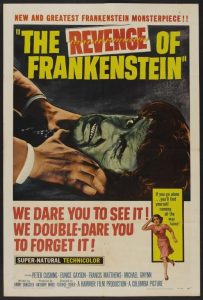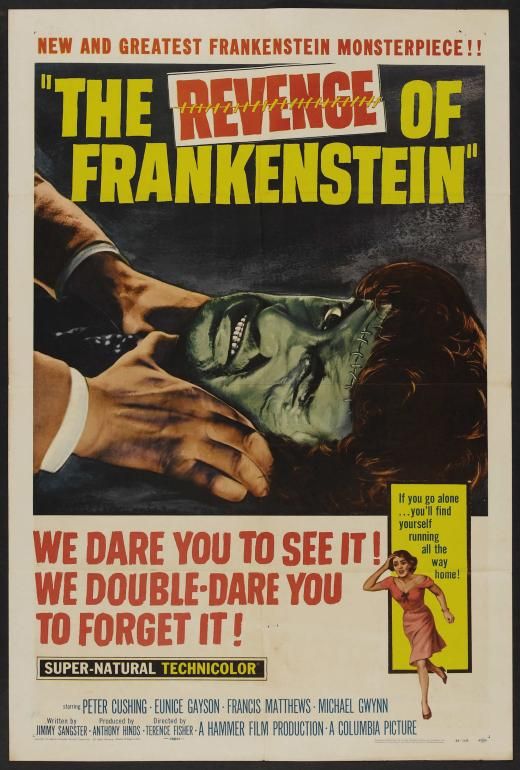
The Revenge Of Frankenstein is the second instalment in Hammer studio’s Frankenstein series. The first film, The Curse Of Frankenstein, was the company’s debut horror feature and a commercial success. It paved the way for a plethora of horror films and made ‘stars’ of Peter Cushing and Christopher Lee. Lee is absent from Revenge. but Cushing returns in the titular role along with director Terence Fisher and writer Jimmy Sangster.
Having narrowly escaped the guillotine, Dr./Baron Frankenstein retreats to a new town to pledge his trade. Adopting the ‘cunning’ pseudonym ‘Dr. Stein’, he opens two medical practices. One serves the wealthy, financing the second which treats the poor and needy. This humanitarian/philanthropist set-up masks the fact that both practices support, in terms of money and body parts respectively, the good doctor’s true interests. He has a secret laboratory in a disused wine cellar where he continues his infamous experiments. After three years in the new town his practice is such a success that the local medical council is becoming redundant. The members hold an emergency meeting to discuss the problem of Dr. Stein.
Terence Fisher’s Frankenstein series concentrates on the doctor (and in turn science) as the source of ‘evil’. Frankenstein’s blind ambition and lack of moral code is the real source of horror. This premise is strikingly different from earlier Frankenstein stories. In the Mary Shelley original, both the doctor and the ‘monster’ are portrayed as victims of science. In James Whale’s celebrated duet the doctor is the misguided hero. In both cases the doctor is misled by scientific ambition but retains a strong moral code throughout. The sinister Dr. Pretorius in Bride Of Frankenstein could be seen as a better prototype for Fisher’s doctor.
In Revenge. rather than retreading the familiar experiment of the previous film(s), a spin has been put on events. Here Frankenstein’s construction of the ‘monster’ has reached its zenith and is given short shrift. Instead the problem and focus of the film is that of the brain. A living brain is required so transplants are in order. Cue a bloodied brain slopping into a specimen jar. Loopy proceedings include a priceless hand-eye co-ordination experiment (every lab should have one) and a cannibalistic chimp with the brain of an orang-utan. The brain transplantation theme is taken the logical step further in And Frankenstein Created Woman, which involves the transfer of the soul.
Although it evokes some viewer sympathy, the ‘monster’ is not as innocent as the creations in earlier films and in a way deserves its fate. Its appearance is not that impressive either, when it goes on the rampage the facial expression and make-up reminded me of Michael Palin. The fact that the ‘monster’ starts to regress back to his half paralytic state suggests that the condition stemmed from the brain, Frankenstein’s diagnosis was wrong.
This is the only error Frankenstein makes. His assistant, Dr. Kleve, and workers (the cleaner is an ‘expert’ on zoology) make them for him. Thus the experiment ends in disaster. If Dr Kleve had not helped Frankenstein with the final transplantation, he could be considered to have been a ‘plant’ from the medical council. The final creation is of course ludicrous. How could the body be a perfect likeness? Still, it paved the way for further sequels.

